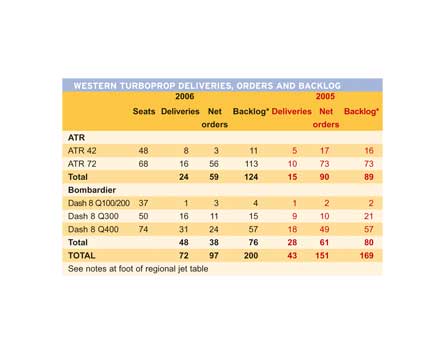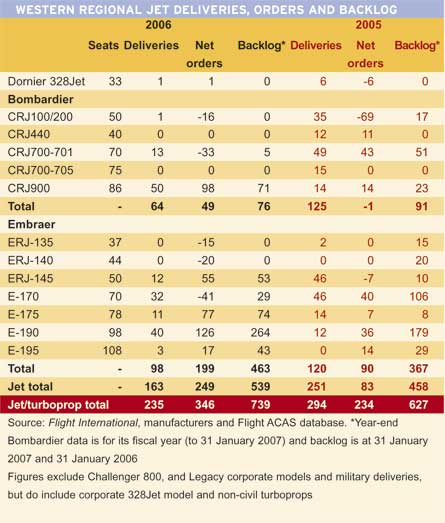Industry sees orders swell in 2006 as turboprop revival gathers momentum, but output declines to a record low
The year 2005 marked the revival of the turboprop, and another strong sales performance last year confirmed that the propeller-driven recovery was no flash in the pan. There was also a significant rise in demand for large regional jets, with Bombardier and Embraer securing over 240 net orders for their CRJ900 and E-190/195 families between them - a development that was no doubt behind the Canadian company's decision to launch a 100-seat CRJ derivative last month.
The regional manufacturing sector saw an increase in demand last year, with the three Western manufacturers - ATR, Bombardier and Embraer - recording an almost 50% improvement in net orders to over 340 aircraft, driven largely by the increased demand for large regional jets and the ongoing recovery of the turboprop market (Bombardier's annual figures and backlog data based on the manufacturer's 2006-7 fiscal year, which ends on 31 January).
Proportionally, the turboprops could not maintain the stranglehold they had on the jets for a second successive year, with net orders accounting for just over a quarter of the total, compared with an almost 60% share in 2005.
Despite the improvement in sales, regional output fell by 20% to an industry low of 235 deliveries (compared with over 370 units five years ago), as 2005's collapse in the market for jets with 50 seats and fewer took its toll on production. This sector, which had been the bread and butter for Bombardier and Embraer since the mid-1990s, remains becalmed.

While regional jet output dropped 35% to around 160 units, turboprop shipments surged by 67% to 72 aircraft - the highest since the beginning of the decade. This put the turboprop market share of output at 30% - a remarkable recovery given that it had dropped as well below 10% only three years ago.
Embraer was the top-performing airframer last year in sales terms, taking 199 orders - which represents 80% of the jet sector and 58% of the entire regional market last year. However, it was Bombardier - despite the cessation of CRJ200 production - that was the most prolific regional builder, delivering 112 aircraft - 64 jets and 48 turboprops. The Canadian manufacturer's regional production declined by a quarter during FY2006-7 and is set to remain flat over the next 12 months at around 115 aircraft. However, the turboprop family will take the lead in output with Q Series production set to rise to 65 while shipments of the CRJ700/900 will decline to 50 aircraft.
"Our Q Series aircraft are well positioned for the continued resurgence in turboprops," says Bombardier Aerospace president and chief operating officer Pierre Beaudoin. "In the last few months, we have made inroads in the US market with the sale of Q400s to Frontier Airlines, while other airlines in the USA are also examining the benefits this aircraft can bring to their operations."
Turboprop rival ATR may have been out-produced by the Q Series last year, but it was the winner in the sales stakes with 59 net orders for its ATR 42/72 family, representing a 60% market share of the turboprop sector.
Speaking earlier this year, ATR chief executive Filippo Bagnato was encouraged that Bombardier's recent US Q Series success was "a good sign" that the country's airlines were again thinking about investing in turboprops. "I think that in 2007 we will see a recovery of the turboprop market in the USA," he says.
ATR was unable to match the extremely strong sales performance it had in 2005, but still secured 59 net orders that pushed its backlog up by 40% to 124 aircraft. The airframer retains a bullish outlook this year, which will see production almost doubling in the next two years. "Our objective in 2007 is to have 60% market share again," says Bagnato. "This year we will deliver 44 aircraft and in 2008 the plan is for 60 aircraft."
Both the regional jet manufacturers experienced further shifts in demand across their product lines last year. The industry's diminishing appetite for regional jets appears to have spread further and afflicted demand for the smaller members of the large (70 seats and above) regional jet families.
Embraer's E-Jet family covers the 70- to 110-seat market, and while it experienced a surge in demand for the larger members (the 175, 190 and 195), its net orders for the smallest member, the E-170, was in serious deficit due to the switching of the 57 orders held by US Airways to the E-190 variant. Meanwhile, all 53 ERJ-145s that remain on backlog are from Chinese companies for the locally assembled version.

Bombardier secured 98 orders for the 86-seat CRJ900 - which until last month, when the 100-seat CRJ1000 was launched, was its largest airliner model. However, the airframer ended its fiscal year with a net order tally for the CRJ700 of minus 33, as the 13 incremental orders placed in FY2006-7 were more than offset by the cancellation of US Airways' 29 remaining orders, and the transfer by SkyWest of its last 17 CRJ700s to the CRJ900.
"Bombardier and Embraer created the 50-seat jet market in the 1990s, but that sector is now saturated. Meanwhile the high fuel prices have brought about a revival of the turboprop market," says Edward Stacy, an analyst at HSBC. "The two regional jet manufacturers are now exploiting a new market for large regional jets that they have created between their original 50-seat niche and the traditional market served by Airbus and Boeing with their narrowbodies."
Bombardier acknowledges that airlines are "focusing on operating economies and are opting for larger and more efficient regional jets" and points out that with its CRJ700/900/1000 family that it "is well positioned to gain a significant share of the demand". The airframer's decision last month to address the gap at the top of its product range was welcomed by one analyst who believes that the company has spent too long "dithering" as it evaluated whether to go ahead with the CSeries while being "out-competed" by Embraer in the 70- to 100-seat sector.
The regional aircraft backlog has begun to recover after two years of decline. It rose by almost a fifth during 2006 to 740 aircraft, with the turboprops remaining in the 25-30% market share zone. However, against the 40- to 80-seat jets (the category where the ATR and Q Series families compete in size), the turboprops hold a clear market lead.
Probably the most credible threat to the two Western regional jet builders comes from the Sukhoi Superjet 100, which has accumulated 61 firm orders as it heads for its expected first flight later this year, but is yet to land that elusive first international customer. Although it is ostensibly a Russian aircraft, this 75- to 98-seat family incorporates a raft of Western-supplied systems and can boast Italy's Alenia Aeronautica as a paid-up strategic partner. If this proves enough to encourage a Western customer to sign up, expect Bombardier and Embraer to quickly sit up and take notice.
For Regional orders and deliveries market share, and backlog analysis by category click here
For regional aircraft deliveries and backlog in the last five years click hereSource: Flight International











































